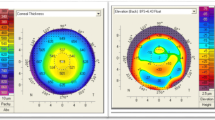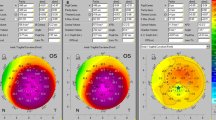Abstract
A variety of methods have been described to both evaluate and document keratoconus progression. In a clinical practice, the ophthalmologist usually evaluates two scans of a patient performed a few months apart to estimate if there is a progression of the disease. Today, besides corneal keratometry, there are many other parameters that are also examined in order to evaluate if the keratoconus is progressing, including change in best-corrected distance visual acuity (CDVA) or uncorrected distance visual acuity (UDVA), manifest refraction, change on the posterior elevation maps, reduction in apical corneal thickness, increase in anterior corneal asymmetry, index of surface variance (ISV), the index of height decentration (IHD), and the maximum anterior saggital curvature (Kmax).
In this chapter, we describe in more detail the possible options of markers or indices that can be used to identify keratoconus progression. We also present the reasons why Belin ABCD progression display can be a good option for the diagnosis of keratoconus change. The advantage of using such a wide number of indexes is to provide reproducible and comparable measurements at different time intervals. We support what many authors have just recently published regarding performing more than one imaging at a time to create reliable results (minimal 3 images, ideally 5 images) and recommend evaluating at least two parameters. Only a deep knowledge of the meaning of all these indexes and values increases reliability in the evaluation of keratoconus progression. Further prospective studies are needed to confirm the importance, applicability, and consistency of each index.
Access this chapter
Tax calculation will be finalised at checkout
Purchases are for personal use only
Similar content being viewed by others
References
Gomes JAP, Tan D, Rapuano CJ, Belin MW, Ambrósio R Jr, Guell JL, et al. Global consensus on keratoconus and ectatic disease. Cornea. 2015;34(4):359–69.
Rabinowitz YS. Keratoconus. Surv Ophthalmol. 1998;42(4):297–319.
Chatzis N, Hafezi F. Progression of keratoconus and efficacy of corneal collagen cross-linking in children and adolescents. J Refract Surg. 2012;28(11):753–8.
Léoni-Mesplié S, Mortemousque B, Touboul D, Malet F, Praud D, Mesplié N, Colin J. Scalability and severity of keratoconus in children. Am J Ophthalmol. 2012;154(7):56–62.
Romano V, Vinciguerra R, Arbabi E, Hicks N, Rosetta P, Vinciguerra P, Kaye SB. J Refract Surg. 2018;34(3):177–80.
Ferdi AC, Nguyen V, Gore DM, Allan BD, Rozema JJ, Watson SL. Keratoconus natural progression. A systematic review and meta-analysis of 11,529 eyes. Ophthalmol. 2019;126(7):935–45.
Barr JT, Wilson BS, Gordon MO, et al. Estimation of the incidence and factors predictive of corneal scarring in the Collaborative Longitudinal Evaluation of Keratoconus (CLEK) Study. Cornea. 2006;25(1):16–25.
Reeves SW, Stinnett S, Adelman RA, Afshari NA. Risk factors for progression to penetrating keratoplasty in patients with keratoconus. Am J Ophthalmol. 2005;140(4):607–11.
Prakash G, Philip R, Srivastava D, Bacero R. Evaluation of the robustness of current quantitative criteria for keratoconus progression and corneal cross-linking. J Refract Surg. 2016;32(7):465–72.
Epstein RL, Chiu YL, Epstein GL. Pentacam HR criteria for curvature change in keratoconus and postoperative LASIK ectasia. J Refract Surg. 2012;28(12):890–4.
Li Y, Tan O, Brass R, Weiss JL, Huang D. Corneal epithelial thickness mapping by Fourier-domain optical coherence tomography in normal and keratoconic eyes. Ophthalmol. 2012;119(12):2425–33.
Li Y, Chamberlain W, Tan O, Brass R, Weiss JL, Huang D. Subclinical keratoconus detection by pattern analysis of corneal and epithelial thickness maps with optical coherence tomography. J Cataract Refrac Surg. 2016;42(2):284–95.
Kanellopoulos AJ, Aslanides IM, Asimellis G. Correlation between epithelial thickness in normal corneas, untreated ectatic corneas, and ectatic corneas previously treated with CXL; is overall epithelial thickness a very early ectasia prognostic factor? Clin Ophthalmol. 2012;6(5):789–800.
Rocha KM, Perez-Straziota CE, Stulting RD, Randleman JB. SD-OCT analysis of regional epithelial thickness profiles in keratoconus, postoperative corneal ectasia, and normal eyes. J Refract Surg. 2013;29(3):173–9. errata, 234.
Ouanezar S, Sandali O, Atia R, Temstet C, Georgeon C, Laroche L, Borderie V, Bouheraoua N. Contribution of Fourier-domain optical coherence tomography to the diagnosis of keratoconus progression. J Cataract Refract Surg. 2019;45(2):159–66.
Choi JA, Kim MS. Progression of keratoconus by longitudinal assessment with corneal topography. Invest Ophthalmol Vis Sci. 2012;53(2):927–35.
Kanellopoulos AJ, Asimellis G. Revisiting keratoconus diagnosis and progression classification based on evaluating of corneal asymmetry indices, derived from Scheimpflug imaging in keratoconic and suspect cases. Clin Ophthalmol. 2013;7(7):1539–48.
Hersh PS, Stulting RD, Muller D, Durrie DS, Rajpal RK. United States multicenter clinical trial of corneal collagen crosslinking for keratoconus treatment. Ophthalmol. 2017;124(9):1259–70.
Witting-Silva C, Chan E, Islam FMA, Wu T, Whiting M, Snibson GR. A randomized, controlled trial of corneal collagen cross-linking in progressive keratoconus. Ophthalmol. 2014;121(4):812–21.
Chowdhury K, Dore C, Burr JM, Bunce C, Raynor M, Edwards M, Larkin DFP. A randomized, controlled, observer-masked trial of corneal cross-linking for progressive keratoconus in children: the KERALINK protocol. BMJ Open. 2019;9:e028761.
Toker E, Çerman E, Ozcan DO, Seferoglu OB. Efficacy of different accelerated corneal crosslinking protocols for progressive keratoconus. J Cataract Refract Surg. 2017;43(8):1089–99.
Mazzotta C, Baiocchi S, Bagaglia AS, Fruschelli M, Meduri A, Rechichi M. Accelerated 15 mW pulsed-light crosslinking to treat progressive keratoconus: two-year clinical results. J Cataract Refract Surg. 2017;43(8):1081–8.
Hashemian H, Jabbarvand M, Khodaparast M, Ameli K. Evaluation of corneal changes after conventional versus accelerated corneal cross-linking: a randomized controlled trial. J Refract Surg. 2014;30(12):837–42.
Aixinjueluo W, Usui T, Miyai T, Toyono T, Sakisaka T, Yamagami S. Accelerated transepithelial corneal cross-linking for progressive keratoconus; a prospective study of 12 months. Br J Ophthalmol. 2017;101(10):1244–9.
Santhiago MR. Corneal crosslinking: the standard protocol. Rev Bras Oftalmol. 2017;76(1):43–9.
Shajari M, Steinwender G, Herrmann K, Kubiak KB, Pavlovic I, Plawetzki E, Schmack I, Kohnene T. Evaluation of keratoconus progression. Br J Ophthalmol. 2019;103(6):551–7.
Choi JA, Kim M-S. Progression of keratoconus by longitudinal assessment with corneal topography. Invest Ophthalmol Vis Sci. 2012;53(2):927–35. Available at: http://iovs.arvojournals.org/article.aspx?articleidZ2188463.
Duncan JK, Belin MW, Borgstrom M. Assessing progression of keratoconus: novel tomographic determinants. Eye Vis. 2016;3(3):1–9.
Muftuoglu O, Ayar O, Ozulken K, Ozyol E, Akinci A. Posterior corneal elevation and back difference corneal elevation in diagnosing forme fruste keratoconus in the fellow eyes of unilateral keratoconus patients. J Cataract Refract Surg. 2013;39(9):1348–57.
Demir S. SönmezB, Yeter V, Ortak H. comparison of normal and keratoconic corneas by Galilei dual-Scheimpflug analyzer. Cont Lens Anterior Eye. 2013;36(5):219–25.
Oshika T, Tanabe T, Tomidokoro A, Amano S. Progression of keratoconus assessed by Fourier analysis of videokeratography data. Ophthalmology. 2002;109(2):339–42.
Suzuki M, Amano S, Honda N, Usui T, Yamagami S, Oshika T. Longitudinal changes in corneal irregular astigmatism and visual acuity in eyes with keratoconus. Jpn J Ophthalmol. 2007;51(4):265–9.
Duncan J, Gomes JA. A new tomographic method of staging/classifying keratoconus: the ABCD grading system. Int J Keratoconus Ectatic Corneal Dis. 2015;4(3):85–93.
Belin MW, Ambrósio R. Scheimpflug imaging for keratoconus and ectatic disease. Indian J Ophthalmol. 2013;61(8):401–6.
Belin MW, Duncan JK. Keratoconus: the ABCD grading system. Klin Monatsbl Augenheilkd. 2016;233(6):701–7.
Villavicencio OF, Gilani F, Henriquez MA, Izquierdo L, Ambrósio RR. Independent population validation of the Belin/Ambrósio enhanced ectasia display: implications for keratoconus studies and screening. Int J Keratoconus Ectatic Corneal Dis. 2014;3(1):1–8.
Belin MW, Villavicencio OF, Ambrósio RR. Tomographic parameters for the detection of keratoconus: suggestions for screening and treatment parameters. Eye Contact Lens. 2014;40(6):326–30.
Orucoglu F, Toker E. Comparative analysis of anterior segment parameters in normal and keratoconus eyes generated by Scheimpflug tomography. J Ophthalmol. 2015;2015:925414. https://doi.org/10.1155/2015/925414.
Belin MW, Meyer JJ, Duncan JK, Gelman R, Borgstrom M. Assessing progression of keratoconus and cross-linking efficacy: the Belin ABCD progression display. Int J Keratoconus Ectatic Corneal Dis. 2017;6(1):1–10.
Sedaghat MR, Momeni-Moghaddam H, Belin MW, Zarei-Ghanavati S, Akbarzadeh R, Sabzi F, et al. Changes in the ABCD keratoconus grade after intracorneal ring segment implantation. Cornea. 2018;37(11):1431–7.
Kosekahya P, Caglayan M, Koc M, Kiziltoprak H, Tekin K, Atilgan CU. Longitudinal evaluation of the progression of keratoconus using a novel progression display. Eye Contact Lens. 2019;45(5):324–30.
Funding/Support
This research received no specific grant from any funding agency in the public, commercial, or not-for-profit sectors.
Financial Disclosures
None of the authors have any financial interest in any products or procedures mentioned in this chapter.
None of the authors have any conflict of interest related to any product or procedure mentioned in this chapter.
Author information
Authors and Affiliations
Editor information
Editors and Affiliations
Rights and permissions
Copyright information
© 2022 The Author(s), under exclusive license to Springer Nature Switzerland AG
About this chapter
Cite this chapter
Tzelikis, P.F., Silva, L.N.P., Rocha, G. (2022). Assessing Keratoconus Progression. In: Almodin, E., Nassaralla, B.A., Sandes, J. (eds) Keratoconus . Springer, Cham. https://doi.org/10.1007/978-3-030-85361-7_15
Download citation
DOI: https://doi.org/10.1007/978-3-030-85361-7_15
Published:
Publisher Name: Springer, Cham
Print ISBN: 978-3-030-85360-0
Online ISBN: 978-3-030-85361-7
eBook Packages: MedicineMedicine (R0)




